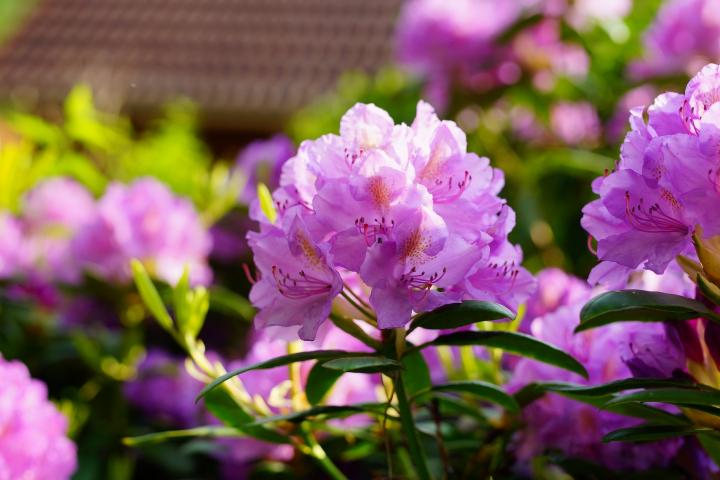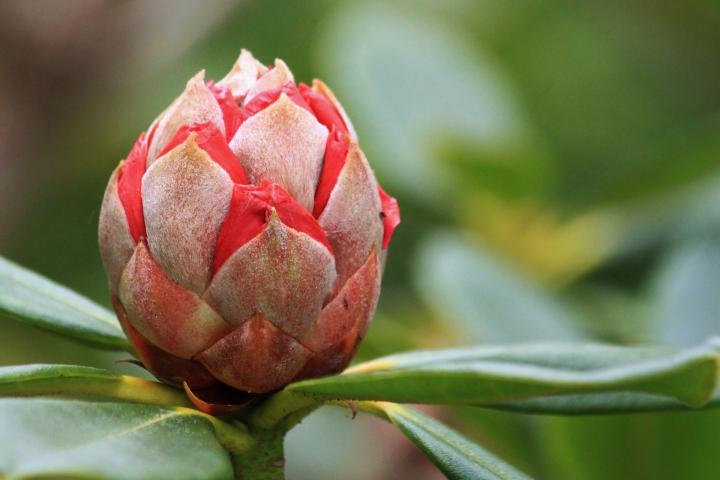Flowering rhododendron and azalea shrubs, both from the genus Rhododendron, have long been mainstays of the garden because their large leaves often stay green through winter. In cold climates, be sure to protect these shallow-rooted plants with a thick layer of mulch. See how to grow and care for rhododendrons!
About Rhododendrons & Azaleas
The clusters of flowers are tubular-, funnel-, or bell-shaped—and often fragrant as well as showy in late spring. The leaves of the smaller azalea are usually pointed and narrow; the leaves of the rhododendron are generally large and leathery.
The two main azalea groups, evergreen and deciduous (varieties that drop their leaves in the fall) can be found in nearly every part of North America, from the frosty Canadian plains to tropical Florida. The rhododendron types are fussier, preferring environments where it is neither too hot nor too cold (Zones 5 to 8). They need a certain amount of chilling to develop strong flower buds. In the winter, protect rhododendrons from cold damage. (See more below.)
With thousands of varieties, there are rhododendrons and azaleas for just about every landscape situation. There are low-growing ground cover azaleas, plants that grow from 1 to 2 feet, as well as plants that can grow up to 25 feet tall. They come in many flower colors, including pink, red, white, yellow, and purple. Though most plants flower in the spring, there are also summer-blooming varieties that add color and charm to the garden.
Explore more tips for growing the best varieties of rhododendrons and azaleas.
Buying Plants
- When shopping for rhododendron or azaleas, pay attention to when they flower. Early varieties can blossom in March, late ones into July or even the fall.
- Buy plants that are a deep green (not yellowed), not wilted, and well watered. Check the soil in the container with your finger and avoid plants that are bone dry.
- If your weather heats to above 90°F in spring, avoid white-flowered azaleas. Their thin petals shatter in the heat.
- In hot climates, buy plants in 3-gallon pots rather than 1-gallon pots. Small plants, with their fewer roots, struggle in the hot late spring and summer.
Choosing and Preparing a Planting Site
- Most large-leafed varieties require dappled shade; avoid deep shade or full sun. A sunny spot that receives a few hours of shade is perfect. See regional guidelines below.
- Soil should be well-drained, humus-rich, moist, and acidic (pH 4.5–6).
- Amend planting areas with compost, peat moss, or a substitute, only if your soil is poor. Learn more about soil amendments and preparing soil for planting.
- Azaleas and rhododendrons have shallow root systems and need moist soil and mulch to keep them from drying out.
Planting in Cold or Temperate Regions (Zones 3 to 6)
- Plant in full sun to increase flowers and avoid mildew problems. Shrubs need a minimum of 6 hours of full sun daily.
- Plant on the sheltered side of a windbreak. If subjected to cold, dry winds, their leaves and buds dry out and die, especially during winter winds.
Planting in Warm or Hot Regions (Zones 7 to 11)
- Plant in a site that receives afternoon shade, especially in hot areas. In tropical zones, azaleas will bloom in full shade.
How to Plant Rhododendron & Azaleas
- Plant in spring or early fall.
- Space plants 2 to 6 feet apart, depending on their estimated mature size. Dig a hole as deep as the root ball and 2 times as wide.
- Set new plants so that their top roots are at soil level or slightly below. If you plant them any deeper, the roots may rot.
- Fill the hole half full with soil, then water it well to settle the soil before filling with remainder of soil.

How to Care for Rhododendron & Azaleas
- Mulch plants every spring with 2 to 5 inches of pine bark chips or pine needles to protect shallow roots and retain soil moisture. A lack of water reduces flower-bud formation.
- Tip: A common mistake is to create a so-called “mulch volcano,” where mulch is piled heavily around the trunk of the shrub. In fact, this can keep the trunk too wet and encourage rot. Always leave a few inches around the trunk free of mulch.
- Fertilize azaleas and rhododendrons sparingly and only when flower buds swell in the early spring, even if they are fall bloomers. Heavy applications of fertilizer will burn the plants.
- Water plants during the summer if rainfall is less than 1 inch per week.
- After flowering, deadhead where practical, to promote vegetative growth rather than seed production. Remove dead flowers from rhododendrons carefully; next year’s buds are just under the old heads and will start to develop shortly after flowering.
- Azaleas and rhododendrons may be transplanted at any time during the growing season, but they transplant most successfully during fall or early spring, when they are dormant and temperatures are cool.
Winter Care for Rhododendrons
Rhododendrons are shallow-rooted plants; in cold regions, apply several inches of organic mulch around the base. In regions with severe winters, wrap evergreen rhododendrons with burlap in the fall. Cold, dry winds will cause too much moisture evaporation from the leaves which will wither and die. To help them recover from cold snaps, deeply water rhododendrons if there are warmer days. In the spring, prune out any dead or damaged branches and leaves.
Pruning Rhododendron & Azaleas
- In general, do not prune spring-flowering shrubs such as azaleas and rhododendrons. If you need to reduce height, prune after flowering in the spring.
- Otherwise, just remove dead, damaged, or diseased branches at any time of year.
- On young and old plants, simply snap off spent flower stalks by bending them over until they break away from their stems. Be careful not to damage growth buds at the base of each flower stalk.

- Vine weevil
- Whiteflies
- Leafhoppers
- Lacebugs
- Scale insects
- Caterpillars
- Aphids
- Powdery mildew
- Bud blast
- Rust
- Leafy gall
- Petal blight
- If soil is not sufficiently acidic, root rot and lime-induced chlorosis could occur.
There are more than 900 species in the Rhododendron genus, which vary greatly. It would take a whole book to understand this wide world!
You may be interested in joining the American Rhododendron Society, which runs a database with information on more than 2,000 rhododendrons and azaleas. On an annual basis, the society selects a number of rhododendrons to be awarded the Rhododendron of the Year designation, highlighting the best-performing plants for different regions.
Here is a handful of varieties that we think you’ll enjoy:
- ‘Blue Diamond’ is a dwarf evergreen rhododendron that grows to 5 feet. It blooms mid-season with violet-blue flowers. Zones 7 to 9.
- ‘Cecile’ is a vigorous azalea that grows to 7 feet and produces dark salmon-pink buds in mid-season. Zones 5 to 8.
- ‘Hydon Dawn’ is a low-growing rhododendron that actually tolerates full sun. Pale pink flowers bloom in mid-season. Zones 7 to 9.
- ‘Nova Zembla’ is an evergreen rhododendron that grows 5 to 10 feet tall and bears bright red flowers in late mid-season. Zones 5 to 8.
- ‘Rosy Lights’ is an azalea that offers extra cold hardiness. It grows to 4 feet and bears deep purple-pink flowers. Zones 3 to 8.
- ‘Purple Gem’ is a dwarf rhododendron which grows to 2 feet and is an early season bloomer. It bears small, light purple flowers. Excellent in the front of a border or in a rock garden. Zones 5 to 8.
The glittering leaves of the rhododendrons
Balance and vibrate in the cool air;
While in the sky above them
White clouds chase each other.
–John Gould Fletcher




